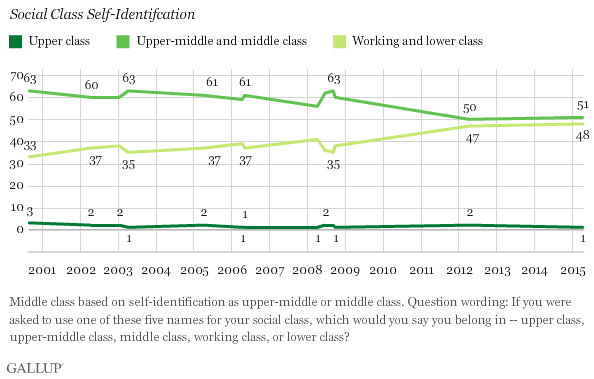PRINCETON, NEW JERSEY — Americans are considerably less likely now than they were in 2008 and years prior to identify themselves as middle class or upper-middle class, while the percentage putting themselves in the working or lower class has risen. Currently, 51% of Americans say they are middle class or upper-middle class, while 48% say they are lower class or working class. In multiple surveys conducted from 2000 through 2008, an average of more than 60% of Americans identified as middle or upper-middle class.

Gallup began asking this five-part social class question in 2000. In that year, and at several points since, a high of 63% of Americans identified as either upper-middle or middle class. The average percentage placing themselves in the two middle-class categories between 2000 and 2008 was 61%.
Gallup didn’t ask the question between 2009 and 2011, but in 2012 and again this year, the combined middle-class percentage dropped significantly, to 50% and 51%, respectively. On the other hand, the percentage of Americans identifying as working and lower class rose to 47% and 48%, up from a low of 33% in 2000.
There are many ways researchers measure subjective social class. This particular question […]











I think it’s great that you posted this. Over the last few days have been in contact with my African american activist friends in Baltimore.. and concurrent with that, I’ve been reading reports about American, British and other countries with you who are finding ways to join ISIS (the majority of the youth I speak of are white.) From what I understanding speaking with friends on the ground in Baltimore, the majority of those who have been setting specific areas of Baltimore on fire are youth. I’m speaking mainly of teens through early 20s who are globally the ones with the highest percentage of unemployment. How do we change this, and how do we convince them we’re on they’re side, when all they see and believe is that change is either taking forever or not happening at all. Concurrent with this are those, like my friends who’ve created youth centers for job training and companies ready to employ them and over the last two days have seen those centers that took years to finance burnt down. They tell me the rage is justifiable, and I have to agree in the case of Baltimore. there are alot of tears and frustration on all sides.
We need to address the challenges of youth and jobs, cuts and closures of schools in lower and middle income areas.